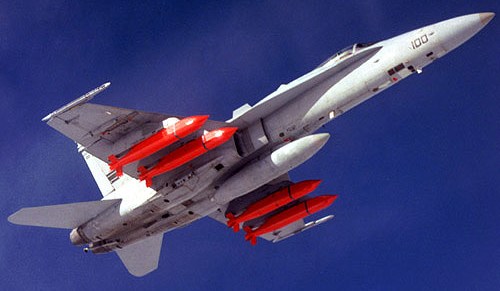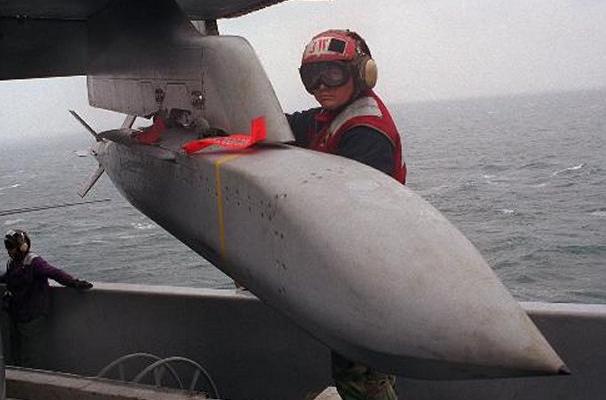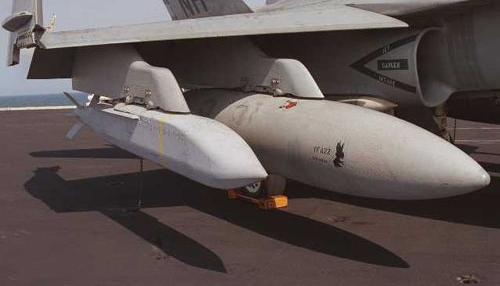Raytheon (Texas Instruments) AGM-154 JSOW
The AGM-154 JSOW (Joint Standoff Weapon) is a modular precision-attack glide bomb, which is included in this missile directory because of its guided missile designation (future versions of JSOW will possibly be powered, though).
In 1986, the U.S. Navy started the AIWS (Advanced Interdiction Weapon System) program to develop a new precision guided short-range standoff attack weapon to replace laser guided weapons like the Paveway series guided bombs, the AGM-123 Skipper II and the AGM-65E Maverick. The primary development goal was a pure fire-and-forget weapon without any post-launch target designation, like a laser designator or a command data link. The AIWS competition was won by Texas Instruments (now Raytheon), who received a contract for the AGM-154A weapon in June 1992. In the same year, the AIWS program was combined with Air Force standoff weapons programs and renamed JSOW (Joint Standoff Weapon). The JSOW requirements called for a low-cost, light-weight weapon with at least 9 km (5 nm) range for low-altitude launches. A lock-on after launch (LOAL) capability was also desired, so that the launching aircraft would not have to put itself into line-of-sight from the target. Another requirement was "quiet launch" capability, i.e. the propulsion system (in any) was to be activated only some time after the release. Because the JSOW was to be used against different kinds of targets, a modular warhead section for cluster and unitary warheads was also required. As a solution to these requirements, Texas Instruments designed a GPS/INS guided unpowered glide bomb. The first guided drop of an AGM-154A occurred In December 1994, and in February 1997 operational evaluation by the U.S. Navy began. Initial Operational Capability (IOC) was reached in 1999, when full-scale production of the AGM-154A began.
 |
| Photo: Raytheon |
| AGM-154A |
The AGM-154A JSOW uses flip-out wings and four cruciform (plus two small horizontal) tailfins for flight control. The glide range is 28 km (15 nm) for low-altitude and up to 74 km (40 nm) for high-altitude launches. Accuracy of the GPS/INS guidance system is better than 3 m (10 ft) CEP. As a warhead, the AGM-154A variant uses a cluster bomb dispenser with 145 BLU-97/B CEM (Combined Effects Munition) bomblets (1.54 kg (3.4 lb) each) for use against soft targets. The DATM-154A is a completely inert shape for JSOW ground handling training.
 |
| Photo: U.S. Navy |
| AGM-154A |
The warhead section of the AGM-154B carries 6 BLU-108/B SFM (Sensor Fuzed Munition) dispensers, each of which can release four "Skeet" terminally guided anti-tank submunitions. Development of the AGM-154B lagged slightly behind that of the AGM-154A, and operational testing was not completed before 2001. IOC was planned for late 2002, but the weapon has now been cancelled. The USAF pulled out of the AGM-154B program because it selected the CBU-115/B WCMD-ER (Wind-Corrected Munitions Dispenser - Extended Range) as its future standoff anti-armour weapon (the CBU-115/B can carry ten BLU-108/B compared to JSOW's six), and the Navy couldn't afford to fund the AGM-154B on its own.
The AGM-154C (developed for the Navy only) uses a "BROACH" multi-stage blast fragmentation/penetrator warhead, developed by BAE Systems (originally, a BLU-111/B warhead was specified). It also features an IIR seeker and ATA (Automatic Target Acquisition) technology (similar to that of the AGM-84H/K SLAM-ER ATA). The ATA feature allows the missile to find the target without intervention of an operator, because the internal logic compares the IIR seeker's image with preset reference images. ATA made it possible to drop the two-way data link which was originally planned for the AGM-154C. The first LRIP (Low-Rate Initial Production) contract for the AGM-154C was awarded to Raytheon in July 2003. The weapon was in OPEVAL (Operational Evaluation) in early 2004, and in December that year full-rate production was approved.
JSOW can currently be used by the F-16, F/A-18 and B-2 aircraft, with the B-52, B-1, and F-15E planned to follow. More than 100 AGM-154As were already used in combat, including Operation Allied Force in Kosovo and Operation Enduring Freedom in Afghanistan. The original total requirement for the USAF and U.S. Navy was for more than 20000 JSOW missiles of all variants, but this will most likely be reduced after cancellation of the AGM-154B.
 |
| Photo: U.S. Navy |
| AGM-154A |
A JSOW variant powered by a tail-mounted Williams WJ24-8 (J400-WR-104) turbojet was tested in 1995 as a contender in the UK's CASOM (Conventionally Armed Standoff Missile) competition (which was eventually won by another competitor). The range for high-altitude launches was increased to about 220 km (120 nm). Although there seems to be no immediate requirement by U.S. forces for a powered JSOW, the designations AGM-154D and AGM-154E were allocated in 2000 to powered derivatives of the AGM-154A and AGM-154C, respectively.
In 2004, Raytheon received a U.S. Navy contract to develop the improved JSOW Block II until early 2006. This version will use an improved Anti-Jam GPS receiver, and unit costs are planned to be lowered by using fewer parts and an improved manufacturing process. As soon as Block II is ready for production, future AGM-154A and -154C missiles will be produced to this standard. Additionally, Raytheon announced that a new JSOW variant is currently developed, using a BLU-111/B 225 kg (500 lb) unitary warhead as payload. The JSOW/BLU-111 is primarily intended for the export market, and is planned to be available by early 2006. The BLU-111 variant is referred to as AGM-154A-1 in some documents.
In May 2007, the U.S. Navy awarded Raytheon a contract to develop the AGM-154C-1, originally known as AGM-154C Block III. This weapon is based on the AGM-154C Block II. It has improved seeker algorithms which enable it to hit a moving target, and also adds a dual-mode (UHF/Link-16) datalink for inflight targeting updates from the launching aircraft. Production of the AGM-154C-1 is scheduled to begin in 2009.
Specifications
Note: Data given by several sources show slight variations. Figures given below may therefore be inaccurate!
Data for AGM-154A (except where noted):
| Length | 4.26 m (14 ft) |
| Wingspan | 2.69 m (8 ft 10 in) |
| Width | 33.8 cm (13.3 in) |
| Weight | 483 kg (1065 lb) |
| Speed | subsonic |
| Range | 74 km (40 nm) (for high-altitude launches) |
| Propulsion | AGM-154A/B/C: none AGM-154D/E: Williams J400-WR-104 turbojet; 1.07 kN (240 lb) |
| Warhead | AGM-154A/D: 145 BLU-97/B submunitions AGM-154B: 6 BLU-108/B submunitions AGM-154C/E: "BROACH" penetrator warhead |
Main Sources
[1] Norman Friedman: "World Naval Weapons Systems, 1997/98", Naval Institute Press, 1997
[2] Hajime Ozu: "Missile 2000 - Reference Guide to World Missile Systems", Shinkigensha, 2000
[3]
"Vision... Presence... Power, A Program Guide to The U.S. Navy", 2002 Edition
[4] Raytheon Website
[5] Greg Goebel: Dumb Bombs & Smart Munitions, 2002
Back to Current Designations Of U.S. Unmanned Military Aerospace Vehicles
Back to Directory of U.S. Military Rockets and Missiles
Last Updated: 24 May 2007